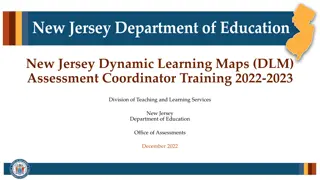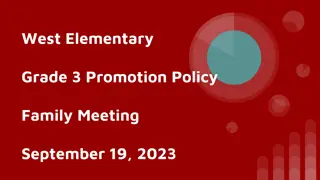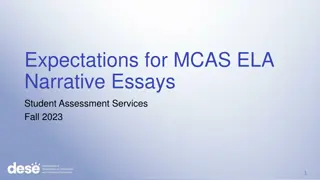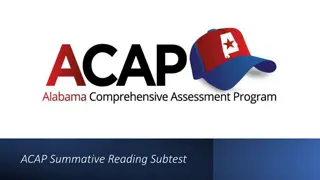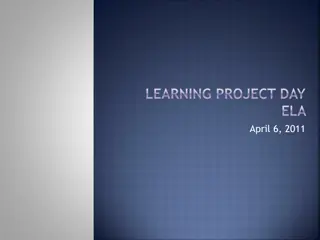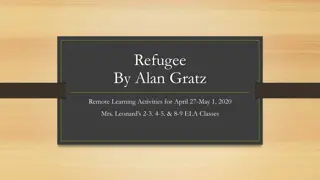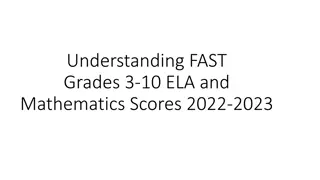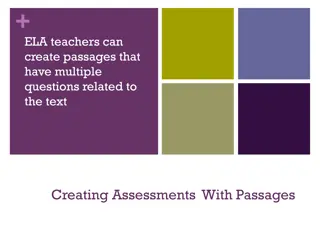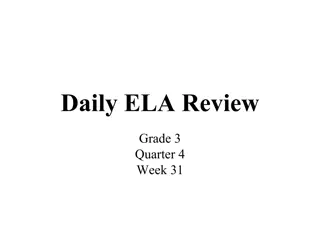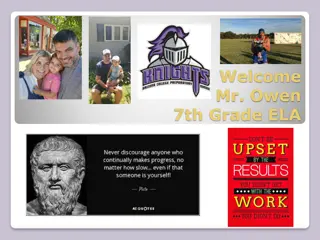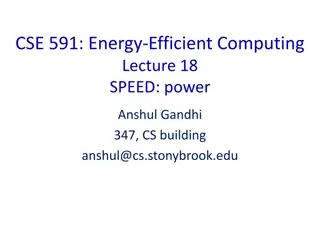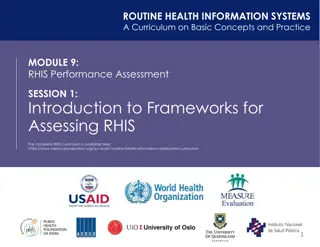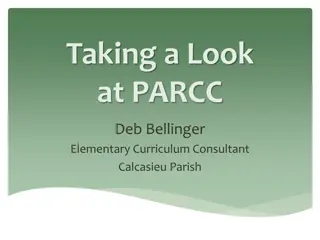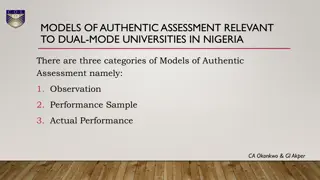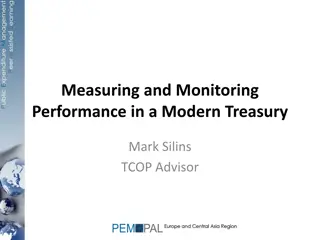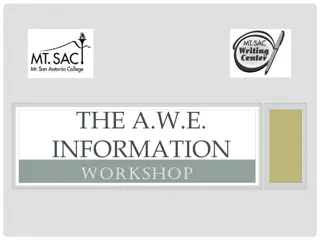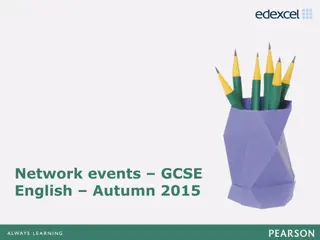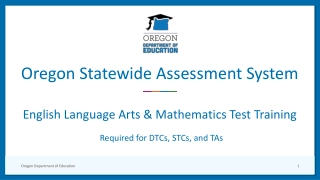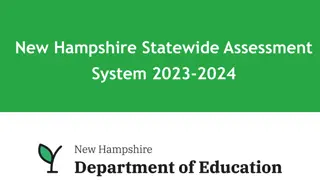The Power of Performance Assessment in ELA Writing
Explore the significance of Passage-based Writing in ELA assessments, covering informative, explanatory, and narrative writing across grades. Understand the scoring process, exemplars, and how to create prompts aligned with writing standards. Gain insights into Claim 2 of M-STEP and the 4-point scoring rubric for online assessments.
Download Presentation

Please find below an Image/Link to download the presentation.
The content on the website is provided AS IS for your information and personal use only. It may not be sold, licensed, or shared on other websites without obtaining consent from the author. Download presentation by click this link. If you encounter any issues during the download, it is possible that the publisher has removed the file from their server.
E N D
Presentation Transcript
1 The Power of Performance Assessment ELA Passage-based Writing PRESENTED BY: NIKKI MOSSER, ELA CONSULTANT JULIE MURPHY, ASSESSMENT SPECIALIST
2 The Power of Performance Assessment ELA Passage-based Writing Presenting information about the Passage-based Writing that is on the M-STEP All grades 3-7 have a PBW Informative Writing Explanatory Writing Reviewing the standards that the items (prompts) are aligned to Grade 3 are aligned to W2 and W8 Grades 4-8 are aligned to W2, W4, W8, and W9
3 The Power of Performance Assessment ELA Passage-based Writing Reviewing the kinds of writing that are on the assessment Narrative Passage Realistic Fiction Poem Informational Biography Explaining the rangefinding process for agreement on scores Discussion of how exemplars are found Using the rangefinding method to score new exemplars
4 The Power of Performance Assessment ELA Passage-based Writing Presenting an example of Passage-based Writing that can be used as a performance task to be explored within the MI-CSS System Examine a grade 3 item called, The Rhinoceros and the Bird Review the PBW rubric that is used to score the PBW Read the passage and review some exemplars Discuss the reasons for the score points given Discussing how to take the examples and turn them into viable prompts to be used with students
5 M-STEP Claim 2 includes Passage-based Writing (PBW) Writing Standard 2: Compose Full Informational Texts on a topic using a complete writing process Passage-based Writing Students read a passage Literary OR Informational Various genres as prescribed by the standards Students respond to prompt after reading the passage using informative/explanatory writing
6 Claim 2 - Writing 4-Point Scoring Rubric Embedded in online experience Not part of CAT algorithm
Sample PBW Prompts Narrative passage - In the story, the character learns a lesson. Write an essay describing how events in the story help the character learn a lesson. All prompts end with Use evidence from the passage to support your response. Realistic fiction - The story has a theme about honesty. Write an essay explaining how the theme is supported throughout the story.
Sample PBW Prompts Poem - Read the lines from the poem. . Write an essay explaining the way the author uses .as a metaphor for Informational - The passage makes a claim about XXX. Write an essay describing how the author supports this claim. Biography - The evidence in the passage suggests that John Doe was successful. Write an essay describing the qualities John possessed that contributed to his success.
9 Claim 2 Writing 4-Point Scoring Rubric
10 Claim 2 - Writing Writer s Bulleted List Remember, a well-written essay: shows understanding of the text uses details from the text for support is organized with an introduction, body, and conclusion uses transitions and clear language follows rules of spelling, punctuation, and grammar
11 Claim 2 - Writing Handouts 4-Point Scoring Rubric https://www.michigan.gov/documents/mde/TDA_R ubric_FINAL_ada_605239_7.pdf Writer s Bulleted List https://www.michigan.gov/mde/0,4615,7-140- 22709_70117-455340--,00.html
12 Grade 3 PBW Aligned to Standard W2 2. Write informative/explanatory texts to examine a topic and convey ideas and information clearly. a. Introduce a topic and group related information together; include illustrations when useful to aiding comprehension. b. Develop the topic with facts, definitions, and details. c. Use linking words and phrases (e.g., also, another, and, more, but) to connect ideas within categories of information. d. Provide a concluding statement or section.
13 Grade 3 PBW Aligned to Standard W8 8. Recall information from experiences or gather information from print and digital sources; take brief notes on sources and sort evidence into provided categories.
14 Grades 4 7 PBW Aligned to standards W2 For Example Grade 5 2. Write informative/explanatory texts to examine a topic and convey ideas and information clearly. a. Introduce a topic clearly, provide a general observation and focus, and group related information logically; include formatting (e.g., headings), illustrations, and multimedia when useful to aiding comprehension. b. Develop the topic with facts, definitions, concrete details, quotations, or other information and examples related to the topic.
15 Grades 4 7 PBW Aligned to standards W2 For Example Grade 5 2. Write informative/explanatory texts to examine a topic and convey ideas and information clearly. c. Link ideas within and across categories of information using words, phrases, and clauses (e.g., in contrast, especially). d. Use precise language and domain-specific vocabulary to inform about or explain the topic. e. Provide a concluding statement or section related to the information or explanation presented.
16 Grades 4 7 PBW Aligned to standards W4 For Example Grade 5 4. Produce clear and coherent writing in which the development and organization are appropriate to task, purpose, and audience. (Grade-specific expectations for writing types are defined in standards 1 3 above.)
17 Grades 4 7 PBW Aligned to standards W8 For Example Grade 5 8. Recall relevant information from experiences or gather relevant information from print and digital sources; summarize or paraphrase information in notes and finished work, and provide a list of sources.
18 Grades 4 7 PBW Aligned to standards W9 For Example Grade 5 9. Draw evidence from literary or informational texts to support analysis, reflection, and research. a. Apply grade 5 Reading standards to literature (e.g., Compare and contrast two or more characters, settings, or events in a story or a drama, drawing on specific details in the text [e.g., how characters interact] ). b. Apply grade 5 Reading standards to informational texts (e.g., Explain how an author uses reasons and evidence to support particular points in a text, identifying which reasons and evidence support which point[s] ).
19 Passage-based Writing Field Test Written by Michigan authors For students in grades 3 8 Field test took place January of 2019 and 2020
20 Rangefinding Rangefinding (RF) is a process in which a committee of educators review student responses from the Passage-based Writing Field Test to find the range of scores. Participants review the responses, and each is discussed within the committee. Finally, a decision is reached on the score for each response. These responses are then utilized to create training sets used to guide readers to score the responses from the field test. RF for the Passage-based Writing Field Test will take place in the beginning of March 2020.
21 Rangefinding This Rangefinding process can be utilize to a smaller extent to score student responses for the Performance Assessment of new prompts. After a new prompt is administered, a small group of educators can review the responses and provide some exemplars.
22 Be Involved! Please encourage the teachers in your district to participate on OEAA Committees. www.michigan.gov/oeaa Assessment Committee Participation Application Learn more about the state s assessment system, collaborate with other educators, and earn a little extra money or SCECHs for your expertise, time, and contributions!
23 Be Involved! Context Review- Narrative and informational text have been written by Michigan authors. Two committees, provide feedback on each passage and writing prompt. Teachers not involved in the item writing process are needed to provide bias and sensitivity-related feedback and recommendations on those items both before and after they have been field tested. Bias and Sensitivity Committee (BSC)- Bias and sensitivity are reviewed at the same time. The purpose of this committee is to review context for bias and sensitivity. Bias-Presence of some characteristic of an item that results in differential performance for two individuals of the same ability but from different subgroups. Sensitivity-Content or language in an item or passage that evokes an unintentional distraction or emotional reaction from the test taker.
24 Be Involved! Content Advisory Committee (CAC)- This committee reviews newly developed context with Michigan educators. Item are reviewed for: content alignment, levels of rigor, technical design, universal design, and accessibility. Item Writing- Teachers develop the items for the Michigan s M-STEP and K-2 assessments. Teachers learn how to design items to assess students understanding of learning expectations and then develop stand- alone items as well as items that will be part of a context.
25 Be Involved! Item Review for Bias/Sensitivity and Content Advisory Committee- Teachers not involved in the item writing process are needed to provide content-related feedback and recommendations on those items both before and after they have been field tested. Item are reviewed for: content alignment, levels of rigor, technical design, universal design, and accessibility. Data Review- Bias/sensitivity and content committees review all data. During this review, the committee is trained to understand and interpret statistics from field tested items. Recommendations from the committee are recorded for items with low statistics.
26 Be Involved! Standard Setting- The process where the descriptions of achievement levels and the minimum scores necessary to be classified into each level (i.e., cutscores) are established. Committee members receive training that outlines the standard setting process, their specific task, and the materials that they will be using. Range Finding- Process in which a committee of educators review student responses from the Passage-based Writing Field Test to find the range of scores.
QR Codewill take you to the application
28 Nikki Mosser ELA Assessment Specialist Office of Educational Assessment and Accountability Michigan Department of Education Julie Murphy Education Assessment Specialist Office of Educational Assessment and Accountability Michigan Department of Education Call Center: 877-560-8378, option 3 mde-oeaa@michigan.gov
29 Example of Performance Tasks Examine a grade 3 item called, The Rhinoceros and the Bird. Review the PBW rubric that is used to score the PBW. Read the passage and review some exemplars. Discuss the reasons for the score points given. We will discuss how to take the examples and turn them into viable prompts to be used with students.
30 Claim 2 Writing 4-Point Scoring Rubric
31 Recently Asked Questions During what portion of the ELA test will students be asked to answer the PBW question: beginning, middle, or towards the end? For the CAT, students will be presented with the passage and writing prompt near the beginning of the test Passage and prompt not part of CAT algorithm For the paper/pencil test, the passage and essay prompt is in the first part of Day 2
32 Recently Asked Questions Does the Passage-based Writing Prompt require students to type their responses, or is it a handwritten response? In the CAT, students will type their response on a keyboard. For the paper/pencil test, students will hand-write their response.
33 Recently Asked Questions In terms of the ELA portion of the test, I know that students will have a PBW question. It sounds like this is the only writing piece. Is that correct? Yes, there is only 1 constructed response. However, there are other questions covering the writing standards. Each student will receive 1 passage with its accompanying writing prompt. The remaining ELA portion consists of reading passages and their associated questions, and stand-alone items.
34 Recently Asked Questions When students complete the writing prompt, how many points is it worth? Are they assessed on a 4-pt rubric? The essay is worth up to 4 points as measured against the rubric. The rubric is posted to the M-STEP website at the link below. https://www.michigan.gov/documents/mde/TDA_Rubric_FINAL_ ada_605239_7.pdf
35 Recently Asked Questions Where can I find examples of the PBW including the bulleted list detailing what is in a good essay? https://www.michigan.gov/mde/0,4615,7-140-22709_70117-456071-- ,00.html


